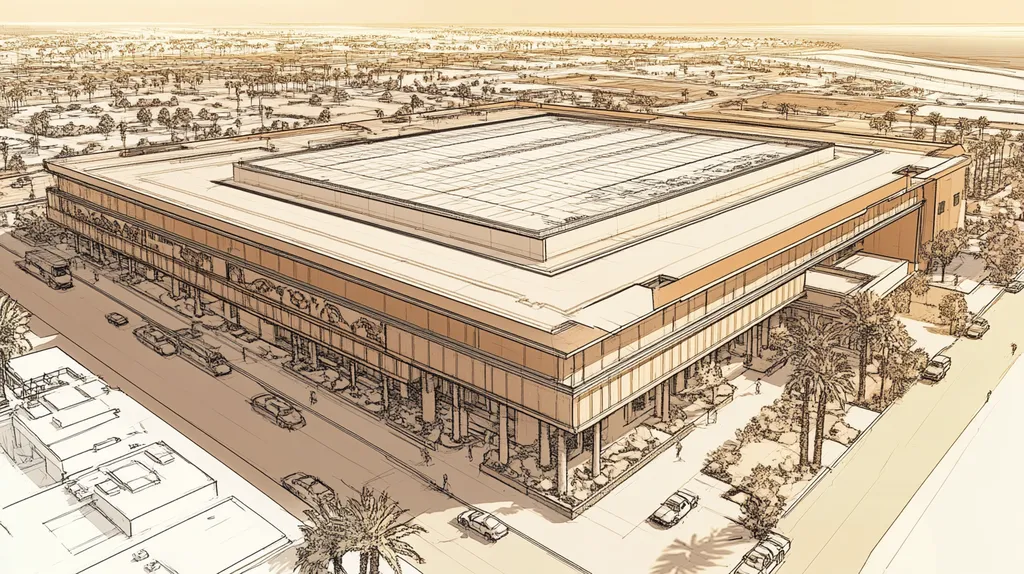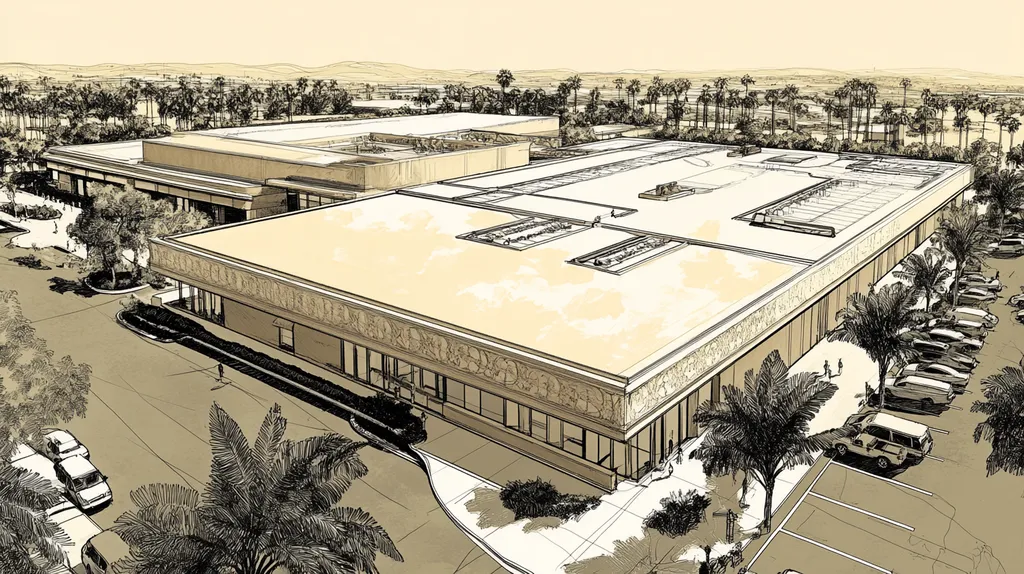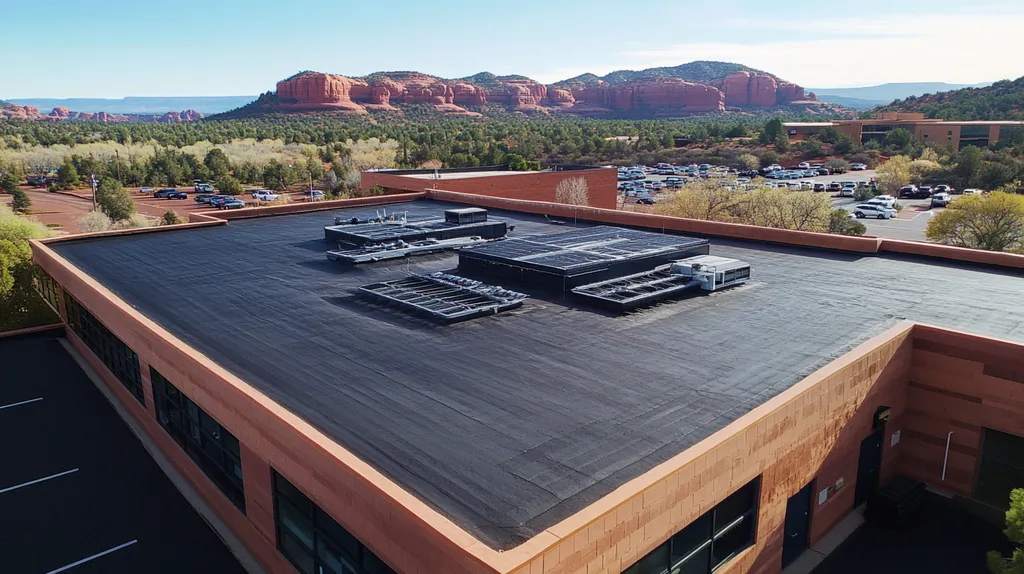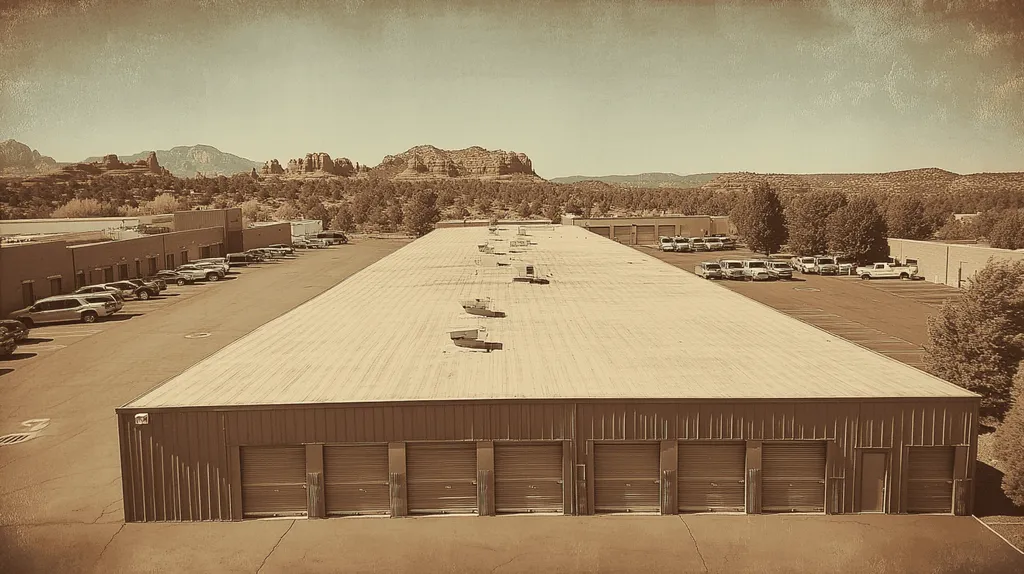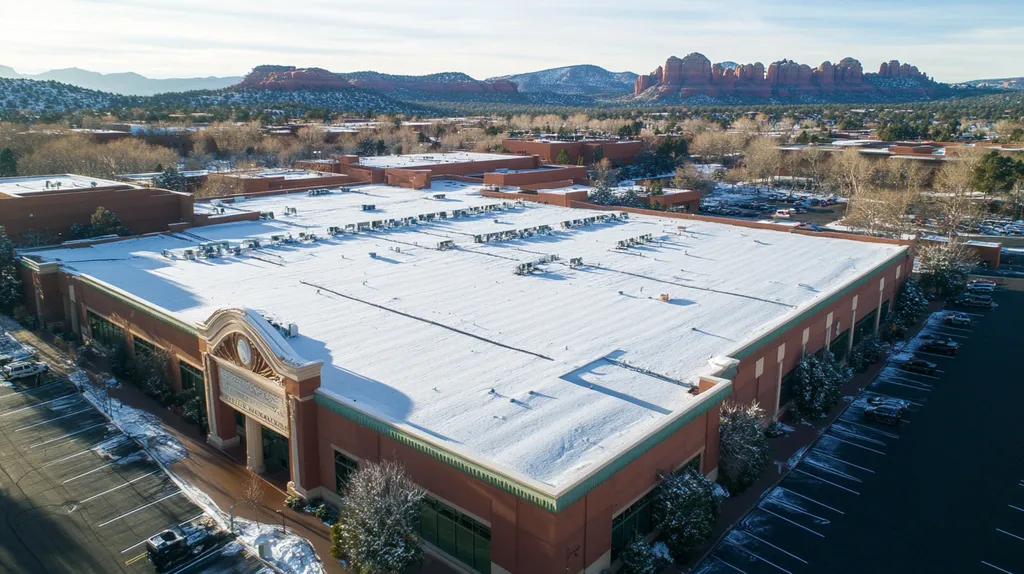Industrial facilities across the U.S. waste an estimated $30 billion annually through inefficient roofing systems that compromise temperature regulation and increase HVAC costs. Recent Department of Energy studies indicate that optimized roofing materials can reduce facility cooling expenses by up to 40%.
For facility managers and property owners, selecting the right energy-efficient roofing materials has become critical as energy prices continue to rise. However, navigating the complex landscape of performance metrics, compliance requirements, and long-term maintenance considerations presents significant challenges.
This comprehensive guide examines the key factors in choosing and implementing energy-efficient roofing solutions, from initial material selection through ongoing operations and risk management.
SECTION 1: PERFORMANCE FACTORS
With rising energy costs, industrial facilities are under increased pressure to cut expenses. According to the U.S. Energy Information Administration, nearly 20% of total energy consumption comes from commercial buildings. Utilizing energy-efficient roofing materials can significantly enhance a facility’s financial performance. Therefore, understanding key performance factors, such as energy efficiency metrics, durability, and weather resistance, is essential for selecting the optimal materials for industrial roofs.
Energy Efficiency Metrics
The energy performance of roofing materials is evaluated using metrics like R-value and solar reflectance. The R-value signifies how well a material resists heat transfer, while solar reflectance gauges the amount of sunlight a roof can repel. Higher values in both metrics can lead to significant reductions in cooling costs during hot weather.
For example, reflective roof coatings can lower surface temperatures by as much as 30 degrees Fahrenheit, translating into cooling energy savings of around 20%, as highlighted by the U.S. Department of Energy.
Conversely, poorly insulated roofs allow excessive heat transfer, causing cooling systems to work harder and consume more energy. Thus, selecting materials with the best energy efficiency metrics is crucial for achieving long-term cost savings.
Additionally, implementing energy management systems can provide valuable insights, enabling facilities to monitor how roofing decisions influence overall energy consumption.
Key Action Items
Durability and Lifespan
Durability is a crucial factor in the long-term effectiveness of roofing materials. Industrial roofs often endure extreme weather conditions, including high temperatures and severe storms. Choosing robust materials that can withstand these stresses will prevent costly repairs in the future.
Metal roofing systems, for example, are known for their impressive longevity, often surpassing 50 years with proper care, while traditional asphalt roofs typically last only 15-20 years.
A roof’s durability directly affects its operational efficiency. Frequent repairs and replacements can disrupt daily operations and result in unexpected costs.
Investing in high-quality, durable materials can lead to longer intervals between maintenance needs, fostering greater energy efficiency and operational stability. Facilities should be mindful of durability to avoid premature roofing decisions.
Key Action Items
Weather Resistance and UV Protection
Weather resistance and UV protection are vital characteristics for industrial roofing materials. Roofs that fail to cope with rain, snow, and harmful UV rays can experience leaks and accelerated wear, resulting in higher energy costs and increased maintenance efforts.
For instance, EPDM (ethylene propylene diene terpolymer) membranes excel in resisting UV damage. Their reflective surfaces help minimize heat absorption, thereby enhancing energy efficiency.
On the contrary, roofs lacking proper weather protection risk moisture infiltration and temperature fluctuations, jeopardizing structural integrity.
Choosing weather-resistant materials is essential for achieving a longer lifespan and maintaining steady energy management across the facility.
Key Action Items
SECTION 2: FINANCIAL CONSIDERATIONS
Roofing decisions in industrial facilities come with substantial financial implications. The choice of materials affects not only the initial installation costs but also ongoing maintenance and energy expenses. Neglecting careful selection can lead to rising operational costs. This section delves into these essential financial factors, underscoring the importance of thorough evaluation and its long-term impacts on the bottom line.
Initial Installation Costs
The initial cost of installing roofing materials is often the first consideration for facility managers. While energy-efficient options like reflective roofing may have higher upfront costs, the long-term savings they offer can be substantial. For instance, low-slope membranes can vary greatly in price depending on their quality and reflectivity.
Investing in high-performance systems may require a premium, but the reduction in cooling costs often pays off quickly. Financing programs, such as energy-efficient retrofit initiatives, can provide assistance to manage these initial expenses. Many utility providers and governments even offer incentives for choosing energy-efficient installations, further reducing financial burdens.
Comparing these costs against projected energy savings is key to making a sound investment decision.
Key Action Items
Long-Term Maintenance Expenses
Long-term maintenance costs are a critical consideration often overlooked during initial budgeting. Selecting lower-quality materials might save money upfront but can lead to escalating repair costs down the line. Durable options like thermoplastic or metal roofs generally require fewer repairs and have longer lifespans.
Regular maintenance can significantly improve energy efficiency, too. For example, dirt buildup can diminish a roof’s reflective properties, necessitating more energy to keep spaces cool. Simple cleaning routines can help retain energy efficiency and stave off unwanted repairs.
Moreover, warranty coverage can drastically influence maintenance costs. Premium materials often come with extended warranties, limiting out-of-pocket expenses related to repairs. Careful assessment of these factors is vital for effective budget management.
Key Action Items
Potential Energy Savings and ROI
Energy savings can deliver significant returns on investment (ROI) for industrial roofing systems. Utilizing reflective and insulated materials can lead to notable reductions in cooling costs, with some facilities experiencing savings of up to 20% annually. Such benefits not only affect the bottom line but also contribute positively to environmental sustainability.
Energy-efficient roofs help lower carbon emissions, enhancing a facility’s image and appeal to eco-conscious clients. The financial returns from these investments can often be realized within 5-7 years, making it essential for property owners to thoroughly analyze the potential savings when considering roofing options.
With effective implementation, energy-efficient materials not only offer cost savings but also support overall sustainability efforts, benefiting both the environment and financial health.
Key Action Items
SECTION 3: COMPLIANCE REQUIREMENTS
For industrial property owners, understanding compliance requirements for roofing materials is essential. Non-compliance with building codes and environmental standards can lead to hefty fines and interruptions in operations. In today’s climate, prioritizing energy efficiency through compliant roofing solutions not only ensures regulatory adherence but can also yield significant savings.
Building Codes and Regulations
Building codes set forth the minimum standards that roofing systems must meet, which influence material selection. Compliance with these codes ensures roofs can endure local climatic conditions, directly impacting energy efficiency. Different regions have unique codes governing insulation, drainage, and structural integrity that must be followed.
For example, northern states typically enforce stricter insulation requirements compared to warmer areas. Property managers must refer to local regulations to ensure roofing systems are compliant. Non-compliance can not only trigger penalties during inspections but also result in inefficient energy usage and higher costs.
Selecting materials that meet or surpass these codes can lower energy consumption and enhance profitability. Collaborating with knowledgeable roofing contractors familiar with local codes simplifies the compliance process, making it easier to select both effective and lawful materials.
Key Action Items
Environmental and Sustainability Standards
Modern roofing materials must adhere to environmental and sustainability standards. Certifications such as LEED promote eco-friendly materials and practices that not only improve energy efficiency but also enhance sustainability. Meeting these standards can significantly reduce energy usage and costs.
For instance, high-reflectivity products can decrease heating and cooling demands by reducing heat absorption. Many states offer financial incentives for buildings that meet these sustainable criteria, providing a valuable opportunity for industrial facility owners.
Implementing sustainable materials and practices also highlights a company’s commitment to environmental stewardship, improving its reputation and attracting environmentally conscious clients. It’s vital to understand the necessary certifications that apply to specific regions.
Key Action Items
Safety and Fire Resistance Compliance
Safety regulations for roofing materials focus primarily on fire resistance and structural soundness. Opting for non-combustible materials helps to reduce fire-related risks. Adhering to safety standards protects the facility’s asset value and employee safety, which is vital for operational continuity.
For industrial facilities, this often involves selecting materials compliant with National Fire Protection Association (NFPA) guidelines, which outline fire resistance ratings to avert catastrophic losses and maintain insurance coverage.
Furthermore, roofs should be engineered to handle hazards like heavy snowfall or high winds. By selecting compliant materials, facilities can enhance safety while optimizing energy efficiency through effective insulation.
Key Action Items
SECTION 4: RISK MANAGEMENT
With rising energy costs and increasingly severe weather events, industrial facilities must make careful choices regarding roofing materials. Poor decisions can result in costly damage, increased operational expenses, and even safety hazards. Effective risk management is vital for ensuring that roofs remain durable and energy-efficient. This section delves into crucial areas such as weather resilience, chemical and fire hazards, and the structural integrity of roofing systems.
Mitigating Weather-Related Damage
Weather-related damage can significantly disrupt operations and drive up energy costs. Industrial roofs are subjected to extreme conditions, including heavy rain, hail, and intense UV exposure. Choosing materials with high resistance to these elements can notably decrease repair costs while improving energy efficiency.
For instance, reflective roofing materials can limit heat absorption, which helps reduce cooling costs in warmer months. Additionally, reinforced membranes offer excellent resistance to punctures and tears, safeguarding roofs from debris and harsh weather. Investing in such materials not only extends the lifespan of the roof but also minimizes the risk of costly repairs.
Routine maintenance checks are essential to identify vulnerabilities before they escalate into serious issues. Implementing proactive measures, like edge protection systems, can help manage water intrusion risks during storms, ensuring facility integrity. Prioritizing durable roofing solutions is crucial for effective risk management, as neglect can lead to significant long-term expenses.
Key Action Items
Reducing Chemical and Fire Hazards
Chemical spills and fire hazards pose serious risks to many industrial facilities. Certain roofing materials can worsen these issues, while others enhance safety. Choosing fire-resistant roofing materials helps prevent rapid fire spread, protecting occupants and assets.
Furthermore, selecting materials that resist chemical degradation is crucial for facilities handling harsh substances. For instance, specialized single-ply membranes can withstand chemical exposure, extending the roof’s lifespan while ensuring safety. These materials help prevent leaks or spills from causing severe complications.
In addition, training staff on hazard recognition and implementing robust safety protocols is essential. This includes establishing clear response guidelines and conducting routine inspections to identify potential hazards. This comprehensive approach significantly boosts operational safety, reinforcing the importance of risk management in facility operations.
Key Action Items
Managing Structural Integrity Risks
The structural integrity of a roof is critical for the overall stability of an industrial facility. Over time, roofing materials can deteriorate and may lose their capacity to support weight and resist stress. This is particularly important for industrial roofs that support additional loads like HVAC units or solar panels.
Investing in high-quality materials with a proven durability record is essential. Engineered roofing systems designed to handle load variances can distribute weight evenly, reducing the risk of sagging or failure. This protects both the roof and the assets it shelters.
Regular inspections are vital for spotting early signs of stress or degradation, preventing minor issues from escalating into major repairs. Technologies like infrared thermal scanning can help detect heat anomalies that signal potential insulation or moisture problems. Utilizing these assessments ensures data-driven maintenance decisions are made.
Key Action Items
SECTION 5: OPERATIONAL PROCEDURES
The success of energy-saving roofing materials hinges on effective operational procedures. Inadequate installation or neglecting maintenance can undermine potential savings, ultimately costing industrial facilities more in the long run. Research indicates that facilities neglecting regular inspection and timely repairs often see a 30% drop in roofing efficiency. This section outlines essential processes to ensure roofs perform effectively while significantly reducing energy costs.
Installation and Commissioning Processes
Successful roofing projects begin with proper installation, which is critical for harnessing the benefits of energy-efficient materials. It is advisable to engage certified contractors who are familiar with the latest installation techniques. Any misstep, such as improper sealing or insulation application, can lead to air leaks, heightening energy costs.
During the commissioning phase, thorough documentation is essential. This should encompass a checklist outlining material specifications, installation techniques, and performance benchmarks. Good documentation not only promotes accountability but also provides a valuable reference for future maintenance.
After installation, testing and validation are critical to ensure the roofing system meets energy performance standards before becoming operational. If a roof does not meet these criteria at the outset, it can lead to increased energy consumption and negate any anticipated savings.
Key Action Items
Regular Maintenance and Inspection
To achieve lasting energy savings, regular maintenance and inspections are critical. A proactive maintenance schedule can help identify minor issues before they develop into major problems, thus preserving the integrity of energy-efficient materials.
Inspections should ideally be conducted biannually, especially following severe weather events. Focus areas during inspections include seams, flashings, and drainage systems, which are often vulnerable to wear. Ignoring these can result in missed early warning signs of deterioration.
It’s crucial to evaluate insulation and reflective surfaces during inspections. If these elements start to degrade or if insulation is compacted, energy expenses could increase. Regular evaluations help assure that roofs maintain their intended performance levels.
Key Action Items
Repair and Replacement Protocols
Clear protocols for repairs and replacements are vital to ensuring that energy-efficient roofs continue to perform effectively. Acting quickly to address minor issues prevents further damage and unnecessary energy loss. Timely intervention for leaks or compromised materials should be a priority.
Repair protocols must also evaluate financial implications, weighing the cost-effectiveness of repairs against full replacements. In certain cases, particularly with aging roofs, a new energy-efficient system might prove more beneficial in the long run.
Contractors should strictly adhere to manufacturer guidelines when executing repairs to uphold warranties and ensure system efficiency. Consistent engagement in training for facility staff on current roofing technologies fosters a forward-thinking approach to repairs and replacements.
Key Action Items
SECTION 5: OPERATIONAL PROCEDURES
The effectiveness of energy-saving roofing materials heavily relies on proper operational procedures. Poor installation or lack of maintenance can negate potential savings, costing industrial facilities in the long run. Research shows that facilities neglecting regular inspections and timely repairs can see up to a 30% drop in roofing efficiency. This section outlines critical processes to ensure roofs not only perform effectively but also contribute significantly to energy cost reductions.
Installation and Commissioning Processes
Proper installation is essential for maximizing the benefits of energy-efficient roofing materials. It’s advisable to hire certified contractors who understand the latest techniques and materials. Mistakes during installation, such as inadequate sealing or improper insulation, can result in air leaks that escalate energy costs.
Thorough documentation during the commissioning phase is crucial. This should include a checklist for material specifications, installation techniques, and performance expectations. Good documentation enhances accountability and serves as a vital reference for future maintenance.
After installation, ensuring proper testing and validation of the roofing system is necessary to confirm it meets energy performance standards before going operational. If a roof fails to meet these standards initially, it could lead to increased energy consumption and nullify anticipated savings.
Finally, training facility staff on the roofing system’s functionality can further enhance energy efficiency. Understanding how the components work together to maintain thermal performance fosters a culture of proactive roof management.
Key Action Items
Regular Maintenance and Inspection
Achieving long-term energy savings requires regular maintenance and inspections of roofing systems. A proactive maintenance schedule can help catch minor issues before they escalate into major problems, preserving the integrity of energy-efficient materials.
Routine inspections should be scheduled at least twice a year, especially after severe weather events. Focus areas during these inspections include seams, flashings, and drainage systems, which are often vulnerable to wear. Neglecting these inspections increases the risk of missing early signs of deterioration.
During inspections, it’s essential to assess the roof’s insulation and reflective surfaces. Degraded reflective materials or compacted insulation can lead to rising energy costs. Consistent evaluations ensure roofs maintain their intended performance levels.
Documenting findings and actions taken during inspections supports ongoing maintenance efforts. This systematic record establishes a history of the roof’s condition, aiding future decisions related to repairs or replacements.
Key Action Items
Repair and Replacement Protocols
Developing clear protocols for repairs and replacements ensures that energy-efficient roofs continue to perform effectively. Swift action to address minor issues can prevent further damage and unnecessary energy loss. Facilities should prioritize rapid intervention for leaks or compromised materials.
Establishing repair protocols should include evaluating whether repairs are cost-effective compared to full replacements. In some instances, particularly with older roofs, investing in a new energy-efficient system could offer better long-term savings.
Contractors must follow manufacturer guidelines during repairs to maintain warranties and operational efficiency. Adhering to these protocols protects the roof’s energy efficiency and prevents potential disruptions.
Lastly, conducting regular training sessions for facility staff on current roofing technologies and materials fosters a proactive mindset toward repairs and replacements. Continuous education empowers staff to make informed decisions that enhance energy efficiency.
Key Action Items
Moving Forward
With industrial facilities losing an estimated $30 billion annually through inefficient roofing systems, the stakes for implementing energy-saving materials have never been higher.
Recent Department of Energy studies demonstrate that optimized roofing solutions can slash cooling costs by up to 40% while extending roof lifespan by 15-20 years.
Success requires a systematic approach incorporating proper material selection, rigorous installation protocols, and consistent maintenance programs.
Facilities that implement comprehensive roofing strategies – from initial compliance through end-of-life planning – position themselves to capture significant energy savings while protecting their infrastructure investments.
The time for industrial facilities to act is now, as rising energy costs and intensifying weather events make efficient roofing systems not just an option, but an operational imperative.
FREQUENTLY ASKED QUESTIONS
Q. What energy efficiency metrics should I consider for my commercial roof?
A. Key metrics include R-value, which measures heat resistance, and solar reflectance, indicating sunlight repulsion. Higher values in both can lead to reduced cooling costs by allowing the roof to stay cooler in hot weather, thereby enhancing energy efficiency.
Q. How can I evaluate long-term maintenance expenses for an industrial roof?
A. Examine the lifespan and warranty of roofing materials. Investing in durable options generally reduces repairs and can improve energy efficiency, thereby translating into long-term savings. Regular cleaning and maintenance will also mitigate costs over time.
Q. What are the compliance requirements for industrial roof materials?
A. Compliance involves adhering to local building codes, insulation requirements, and environmental standards. Ensure that selected materials meet necessary regulations to avoid penalties and improve energy efficiency, ultimately impacting operational costs.
Q. How can I manage risks associated with my industrial roof?
A. Mitigate risks by selecting durable roofing materials that withstand severe weather. Regular inspections can identify vulnerabilities before they lead to costly repairs. Implementing proactive measures like edge protection can also help manage water intrusion risks during storms.
Q. What operational procedures are critical for maintaining energy efficiency in roofing?
A. Establish proper installation protocols, conduct regular inspections, and adhere to maintenance routines. Documenting findings aids in ongoing efficiency and identifying issues early, ensuring your energy-saving initiatives are effectively sustained over time.
Q. How do roofing materials affect energy savings?
A. Energy-efficient materials help minimize energy consumption through improved insulation and reflectivity, effectively reducing heating and cooling costs. This can lead to significant energy savings, enhancing both financial performance and environmental impact.
Q. What specifications should I look for in energy-efficient roofing materials?
A. Look for high R-values for insulation, strong UV protection, and durable material composition. Materials that reflect sunlight can help keep buildings cooler and lower energy costs, enhancing overall efficiency.

